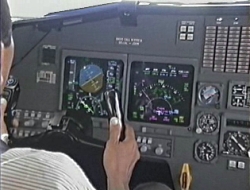An hour before accident the wind speed reached 226 Km/h
(see graph below)
Offshore lights that guide pilots into Jamaica's main airport had been knocked out for more than a month when an American Airlines jet landed in driving rain and overshot the runway.
Lights leading to the other end of the runway were functioning, but wind conditions made that approach less desirable.
It had taken off from Miami International Airport at 8:52 p.m. And arrived in Kingston at 10:22 p.m.
KIN: Offset ILS DME (LLZ 120°, RWY 117°) 3° GS, DA 278, RWY Elev 8
Runway 12 Elevations - Landing end, 8. ARP (mid-runway) 10, far end 17.
Runway 12 wet, Braking Action is Good
GOOD: No degradation of braking action.
FAIR: Somewhat degraded braking conditions.
POOR: Very degraded braking conditions.
NIL: No braking action.
Aerodynamic, not disc, braking is more important when runway conditions have deteriorated enough to necessitate a braking action report. To use the aerodynamic braking action the engineers gave you, first fly at the correct approach speed. Then, once in the landing flare, hold the aircraft’s nose off the runway as long as possible to aid in aerodynamic braking. Finally, when the airplane has settled on the runway use the brakes sparingly – or not at all. This is not the time to slam on the brakes to make the first taxiway. Good rudder and aileron skills will also come in handy – the longitudinal axis of the airplane should be aligned with the runway centerline. This seems rudimentary until one wheel hits the ice first and causes a sudden jolt.
Remember, any braking action report implies that braking action is diminished – the only question pilots have to answer is “by how much?”.
These practices should keep you heading down the runway when braking action reports are GOOD or FAIR.
REILs not operating
Runway End Identifier Lights
REILs are installed at many airfields to provide rapid and positive identification of the approach end of a particular runway. They are effective for:
a. Identification of a runway surrounded by a preponderance of other lighting;
b. Identification of a runway which lacks contrast with surrounding terrain; and
c. Identification of a runway during reduced visibility.
These lights consist of a pair of synchronized flashing lights located on each side of the runway threshold facing the approach area. Both Runway 12 and Runway 30 have omni-directional REILs. The REIL system can be replaced with funding assistance from the JCAA to allow for improved pilot control. Pilots may adjust the intensity of the lights as they approach for landing by keying or “clicking” the aircraft’s microphone in accordance with the Pilot Control Lighting Operating Procedures.
"The only instrument approaches approaches at KIN are for runway 12 because the wind is usually easterly. An ILS was put in a couple of years ago on RWY 12. This ILS is offset requiring an adjustment by about 400 feet to align with the runway."
"If you wanted to land on RWY 30 and it was raining heavy it is unlikely you would be able to see to descend visually below the MSA which is about 9000' due to the mountains to the North.
BF
BF
"Norman Manley International [airport] is a good place when the weather is okay, but it has an ILS approach that is offset 3 degrees to the runway. Doesn't sound like a lot, but when you break out of the clouds the runway isn't right in front of you like other ILS approaches. When you do touch down, the runway isn't grooved and standing water is a problem. Also, accumulated rubber from many prior landings make the touchdown area really slick. The controllers are notorious for calling the winds "calm" when they're really not so. Still, all in all it's not the worst airport we fly into. If you told me we'd have a runway overrun accident I'd have told you it would happen at Managua or Guatemala City. Both are worse than Kingston."














Nenhum comentário:
Postar um comentário